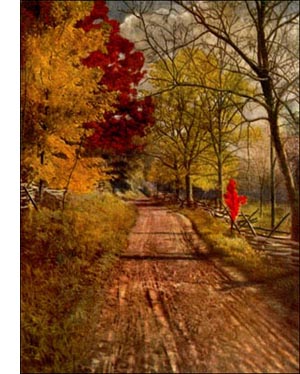Balm of Gilead Poplar Tree
 Balm of Gilead (Populus balsamifera, Linn.)-Large tree with stout trunk, 75 to 100 feet high. Bark grey, broken into broad ridges; branches greenish, smooth or with warty outgrowths. Wood pale, soft, compact, weak, light brown. Buds long, slender, shining with yellow wax. Leaves broadly ovate, acute, finely and bluntly toothed, thick, shining, dark green, pale, often rusty beneath, 3 to 5 inches long; petioles slender; autumn colour yellow. Flowers, March, before leaves; aments drooping, hairy; stamens 18 to 30, crowded on disc; anthers pale red; pistils green with spreading stigmas; flowers scattered. Fruits, May, capsules scattered on stems 4 to 6 inches long; seed brown, buried in cottony float. Preferred habitat, moist or dry soil near water. Distribution, Newfoundland to Hudson Bay and Alaska; south to Maine, New York, Michigan. Nebraska, Idaho and British Columbia. Uses: Well worthy of planting for shade, ornament and shelter.
Balm of Gilead (Populus balsamifera, Linn.)-Large tree with stout trunk, 75 to 100 feet high. Bark grey, broken into broad ridges; branches greenish, smooth or with warty outgrowths. Wood pale, soft, compact, weak, light brown. Buds long, slender, shining with yellow wax. Leaves broadly ovate, acute, finely and bluntly toothed, thick, shining, dark green, pale, often rusty beneath, 3 to 5 inches long; petioles slender; autumn colour yellow. Flowers, March, before leaves; aments drooping, hairy; stamens 18 to 30, crowded on disc; anthers pale red; pistils green with spreading stigmas; flowers scattered. Fruits, May, capsules scattered on stems 4 to 6 inches long; seed brown, buried in cottony float. Preferred habitat, moist or dry soil near water. Distribution, Newfoundland to Hudson Bay and Alaska; south to Maine, New York, Michigan. Nebraska, Idaho and British Columbia. Uses: Well worthy of planting for shade, ornament and shelter.The fragrant wax that saturates the winter buds and coats the young leaves in spring gives this tree its name. The bees find it as soon as the sap stirs and the wax softens. Quantities of it are collected and stored in hives "against a rainy day"; for this is what bees use to seal up weather cracks in their hives. It is known to bee keepers as "propolis." The service this wax renders the tree is to prevent the loss of water from the buds, and the absorption of more, after they are ready for winter. It is not "to keep the buds from freezing," as some people fondly imagine. The buds freeze solid, but it does them no harm. They are adjusted to it. In the far North the Indian uses the balsam of Balm of Gilead trees to seal up the seams of his birch-bark canoe, and of dishes and other utensils made of the same material.
The forests of Balm of Gilead stretch away over the lake margins and bottom lands of upper Canada, the largest and most prominent feature of vegetation in the vast regions that approach the Arctic circle, and extend down into the northern tier of states, from ocean to ocean.
The chief interest that centres about the tree is its good record when planted as a shade and ornamental tree, and in shelter belts. It is a hardy tree of excellent habit, compact and erect, but not too narrow for shade. I t is easily propagated and transplanted, and grows rapidly. The tree is handsome, winter and summer. It has all the good points of the Carolina poplar, and lacks its fault of becoming so soon an unsightly cripple.